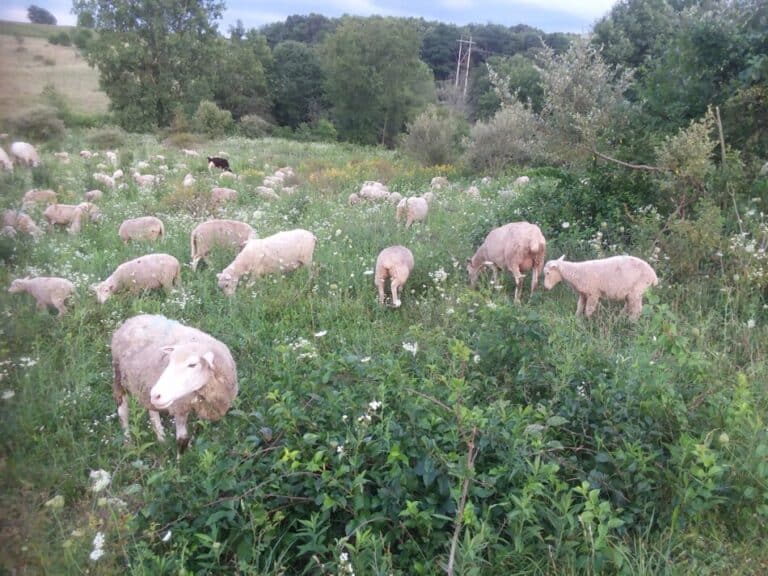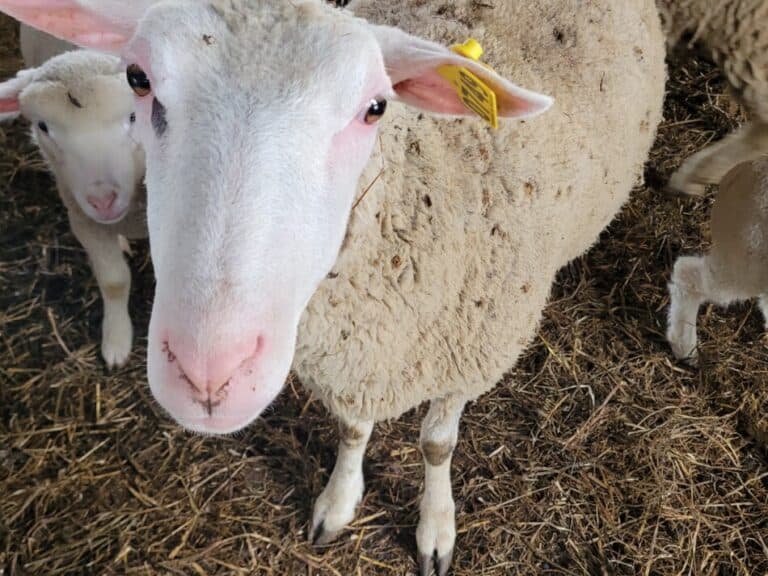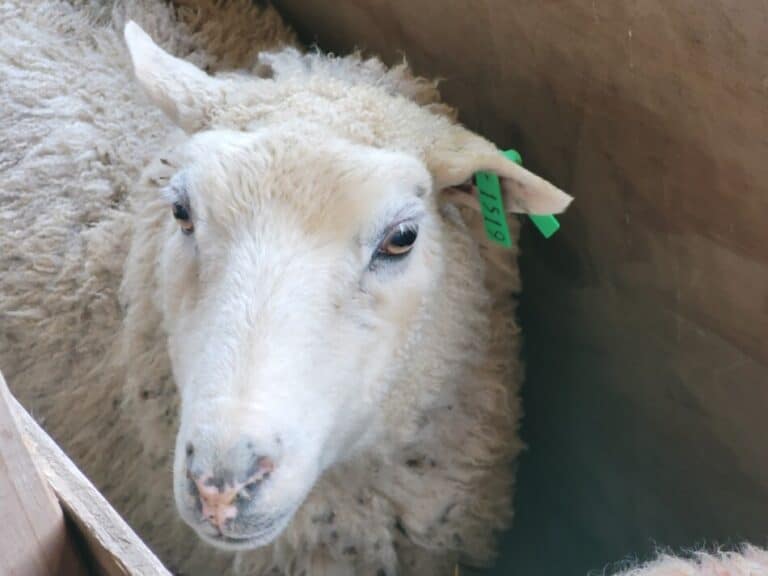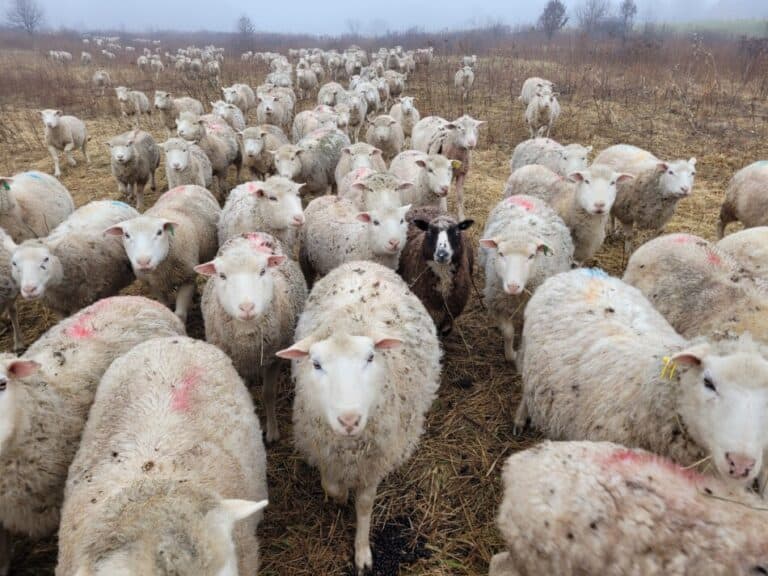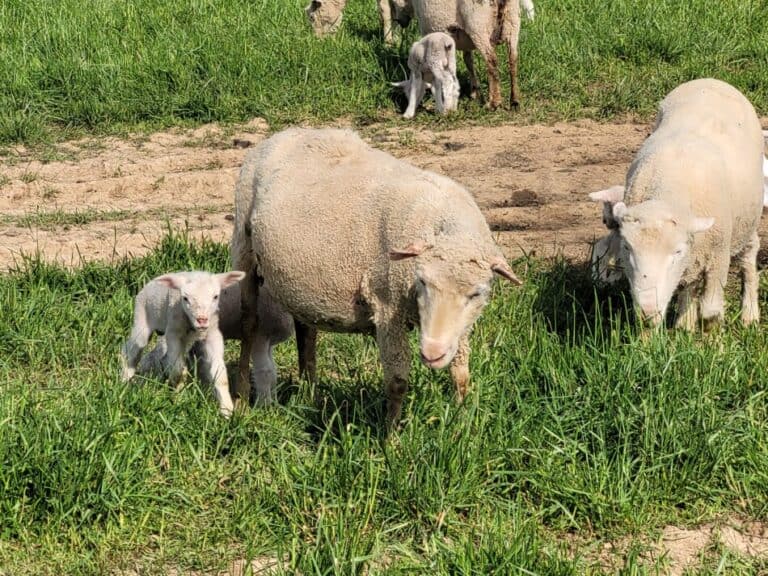How Much Space Do You Need To Raise Sheep?
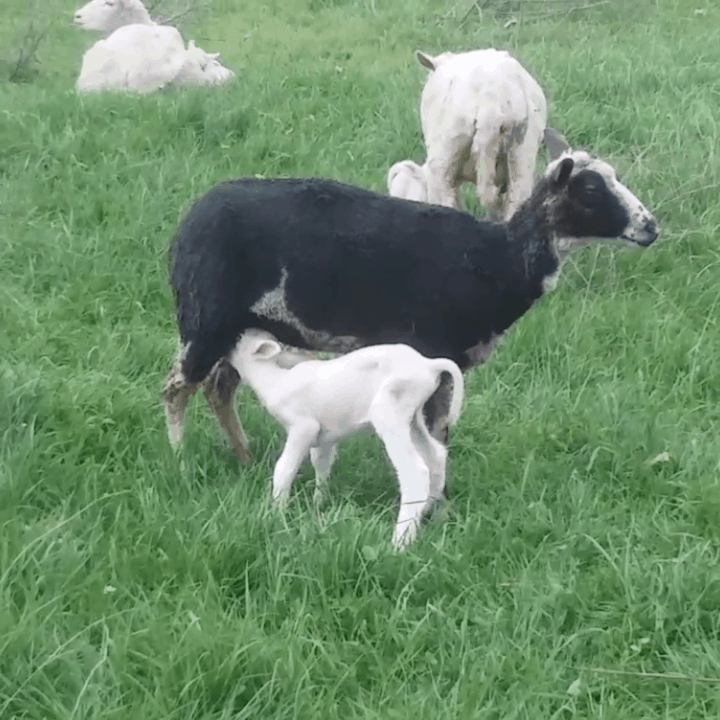
If you’ve got extra grass, you need sheep! Sheep are easy to handle, grazing machines that are the classic four legged lawn mower.
How much space do you need to keep sheep, for both pasture and in the barn?
You need 3.6 acres of grazing for a flock of 20 sheep (130 pounds each) in an area with high forage production (3 tons per acre hay) and an 8 month grazing season. Ewes with lambs need 20 sq. ft. of pen space per ewe.
Sheep are small area and backyard friendly! Anyone with some extra grass can raise at least a few sheep for themselves or to sell.
We’ll start off with general, kind of “generic sheep” stats to give you a basic idea of the things you’ll need to figure out.
Raising Sheep For Profit is an article I wrote that includes current prices for market lambs.
Then we’ll move to the specifics on grazing area and barn space needed for your sheep and your area.
| 8 month Grazing Season (balance of year is hay) | Flock of 20 Ewes @ 130# per ewe |
| High forage production area (3 tons per acre hay equivalent) | 3.6 acres |
| Medium forage production area (2 tons per acre hay equivalent) | 5.3 acres |
| Low forage production area (1 ton per acre hay equivalent) | 10.5 acres |
| Providing all feed (hay and/or concentrates) grass is an exercise area only, not main feed source | 14.23 tons of hay |
| Barn space flock of 20 bred ewes | 320 sq. ft. |
| Barn space flock of 20 lactating ewes | 400 sq. ft. |
Sheep need both pasture and barn space
For most folks, when you’re wondering about the space needed to raise sheep, you’d be thinking of sheep on pasture.
Me, too! Sheep are love to be outside and can spend most of their time on pasture.
But, you’ll also need some “barn time” even if it’s just for heath related care of the flock. For now, we’ll keep the focus on the grass your sheep need.
Number of sheep per acre depends upon forage and management
The number of sheep your land can support per acre, called sheep per acre, is based on the forage growth per year on your farm and your management system.
Notice I wrote “on your farm” not in your area, your farm is different than your neighbor’s land.
Also note the “your management system” part. The way you manage your flock and your land will determine your results.
For instance, planned rotational grazing will give your more grazing per acre than set stocking (leaving the sheep in one area for a long time).
Since both you and your land are variables at this point, we’ll get into some figures to help you get some specifics.
It would be misleading of me to say ___ acres for ___ sheep no matter where you live.
These stats are very area and management dependent, so we’ll need to do a bit of math to figure out what works for your situation.
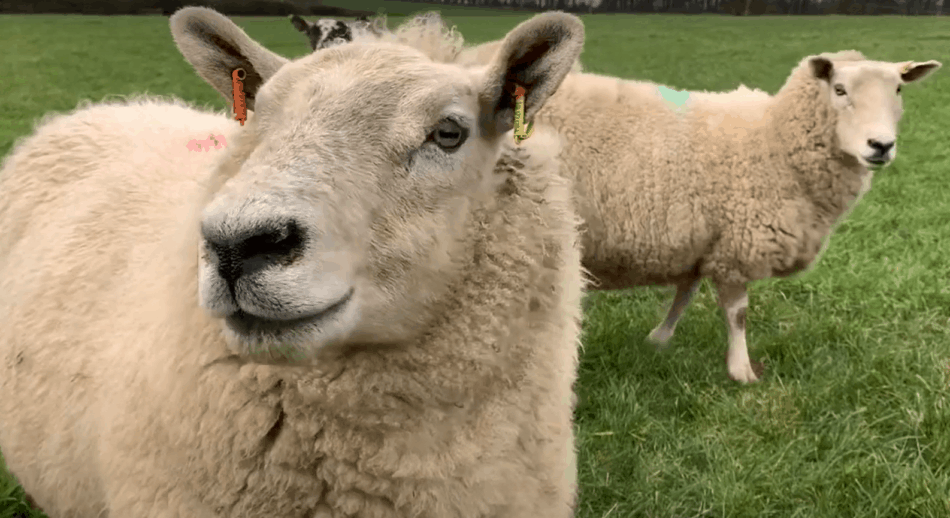
To figure pasture acres needed, know hay equivalent per sheep
Why do you need to know this hay equivalent stuff?
We need to figure up the hay production for an acre to give us a way to measure the grass grown on that acre. It’s hard to measure growing grass!
Once we know the production of your acreage, we can get into the math to help you figure out what amount of grazing your area can support.
If you just want a flock of sheep as a hobby and don’t care how much hay you have to buy for them when they run out of grass, then you don’t need to worry so much about this section.
If your flock is a business, you need to know these numbers
If you are considering your flock to be a business, now things are different.
I am figuring you want to have your flock able to get the majority of their diet from your land for at least part of the year.
If so, you’ll need to work through the math with me.
Using hay equivalents makes your flock’s forage needs comparable
The forages are all “turned into hay” equivalents to make the math the same for differing areas and forage availability.
Sheep need to eat 3% of their body weight in hay per day, as an average. Lactating ewes will need more, gestating ewes, less.
3% is hay or hay equivalent, meaning grass or haylage are included here, as well.
Anytime you see the word “hay” it really means whatever the sheep are eating for the day. Don’t get hung up on the word hay, it just means food.
Calculate the hay eaten per day per ewe
| Weight of ewes (per head) | Hay per day (per head) | Flock of 20 sheep will eat (per day) | Flock of 50 sheep will eat (per day) |
| 120 pounds | 3.6 pounds | 72 pounds hay | 180 pounds hay |
| 130 pounds | 3.9 pounds | 78 pounds hay | 195 pounds hay |
| 140 pounds | 4.2 pounds | 84 pounds hay | 210 pounds hay |
If you have 20 ewes at 130 pounds each, you’ll need to have 78 pounds of hay available per day to feed your flock.
Calculate the total hay needed for the flock
Looking at the table below, you’ll see that you would need 14.23 tons of hay or hay equivalent to feed your flock of 20 ewes for the year.
If that number looks crazy high to you, don’t panic. Remember, the grass your sheep will be grazing is included here too. We’ll sort that out next.
| Weight of ewes (per head) | Hay per year (per head) | Flock of 20 (total for year) | Flock of 50 (total for year) |
| 120 pounds | 1,314 pounds (.65 tons) | 26,280 pounds (13.14 tons) | 65,700 pounds (32.85 tons) |
| 130 pounds | 1,423.5 pounds (.71 tons) | 28,470 pounds (14.23 tons) | 71,175 pounds (35.58 tons) |
| 140 pounds | 1,533 pounds (.76 tons) | 30,660 pounds (15.33 tons) | 76,650 pounds (38.33 tons) |
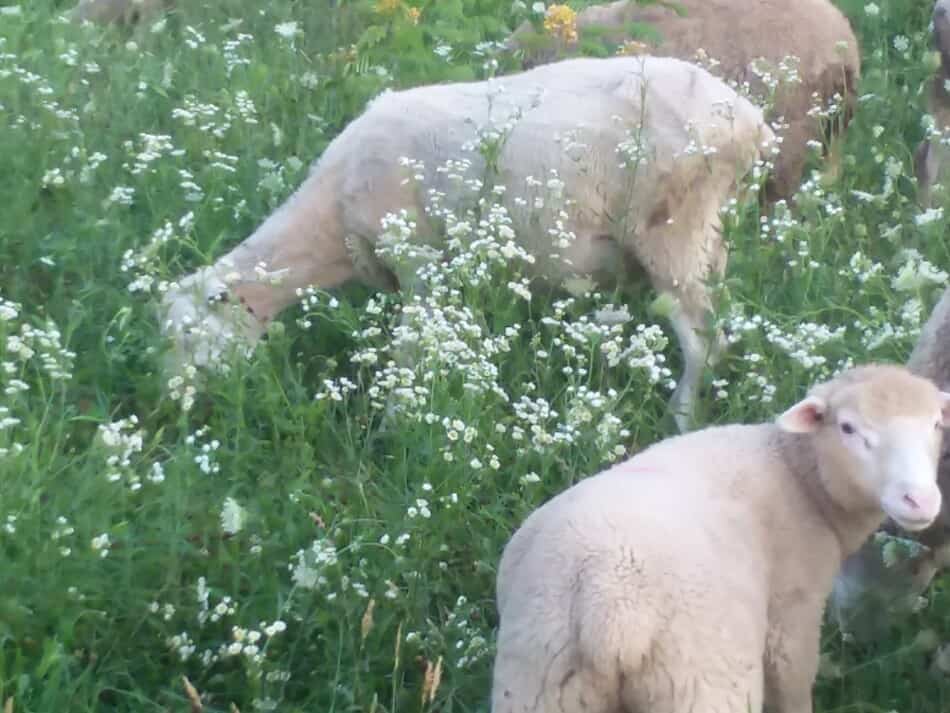
Find how much grass your area will grow for your sheep
The first table is forage production and ewe needs per year, not for the grazing season!
We’ll sort out grazing season next, for now what can you expect land in your area to grow, forage wise?
| Forage production per acre per year (as hay equivalent) | 120# ewes per acre | 130# ewes per acre | 140# ewes per acre |
| High (3 tons or 6,000 pounds) | 4-5 ewes | 4 ewes | 4 ewes |
| Medium (2 tons or 4,000 pounds) | 3 | 3 | 2 |
| Low (1 ton or 2,000 pounds) | 1.5 | 1.4 | 1.3 |
Look to local farmers or the agronomy guide for these numbers
First off, look to your fellow farmers. What are they getting as far as hay per acre?
If you explain what you are trying to figure out, most people will be happy to tell you their experience in growing forages in your area.
If you are having trouble finding this information, look at your state agronomy guide.
The Ohio Agronomy Guide will give you an idea of what you are looking for.
Sadly, these publications always push grain cropping, but just ignore that stuff and head to the grazing and forage production section.
It will have a section on grazing equivalents (based on animal units), which will show cows per acre based on weight. Usually it lists out sheep, as well.
If you can’t find the animal units, look for the hay production per acre. Go with a common grass for your area, or something like a mixed grass hay.
Another possible source of forage production information in your area is the FSA (Farm Service Agency) office and the local Extension (4-H) office.
These are government funded offices with the purpose of promoting agriculture. Your taxes are paying for these services, use them.
Know the length of the grazing season for your flock
| Sheep on grass during grazing season only (hay in winter) | 120# ewes per acre | 130# ewes per acre | 140# ewes per acre |
| 6 months grazing 6 months hay feeding | High: 9.1 Med: 6.1 Low: 3.0 | 8.5 5.6 2.8 | 7.8 5.2 2.6 |
| 7 months grazing 5 months hay feeding | High: 7.8 Med: 5.2 Low: 2.6 | 7.2 4.8 2.4 | 6.7 4.5 2.2 |
| 8 months grazing 4 months hay feeding | High: 6.1 Med: 4.5 Low: 2.2 | 5.6 3.8 1.9 | 5.2 3.5 1.7 |
The length of the grazing season for your area will, change from year to year, but there will be a normal starting point.
We are in North Central Ohio, and we hope for an 8 month grazing season, from April 1st through December 1st. This is best case scenario, I’ll admit.
Some years there is a slow start to spring or an early snow, but 8 months is what we are shooting for.
We go with when the grass starts to green up, which is normally April. Hopefully early April!
The end of the grazing season depends upon the year, as well.
Think about the months of the year when you need to mow your lawn, that’s basically your grazing season.
For us, we plan to graze into November, hopefully December, usually depending upon the wetness of the fields and snow cover.
Figure acres needed based on pasture growth and grazing season
| Flock size (130# sheep) | Pasture production | Grazing only season (balance of year is hay) | Acres needed for flock |
| 20 sheep | High | 8 month | 3.6 acres |
| 20 sheep | Med | 8 month | 5.3 acres |
| 20 sheep | Low | 8 month | 10.5 acres |
| 20 sheep | High | 6 month | 2.4 acres |
| 20 sheep | Med | 6 month | 3.6 acres |
| 20 sheep | Low | 6 month | 7.1 acres |
It’s important to know that if you plan a rotation for your grass, you will get more grass growth for your area than if you just let the sheep out in one area for the whole grazing season.
Section off and rotate the sheep through the grass
This means that if you run a planned rotation in your grazing area, you are likely to get more grass growth than these charts suggest.
If planning and rotating sounds like too much, just start with dividing the area in half and see how it goes.
Any divisions, to give the grass time to rest and regrow, are better than none!
The main point is to let the sheep eat most of the grass, not all, and then move them to another area, while keeping them off of the area they just ate.
This will give you more total grass growth on the acreage that you have for your sheep.
Not rotating the sheep will reduce grass growth
If you set stock, give the sheep all the area at once and leave them there for the whole grazing season, you’ll get less grass growth per acre.
Set stocking is the easy thing to do, but it’s also the least productive.
Sheep will need shelter and a working area
Chances are that at least some of the year you are going to want to have your sheep in a barn or at least a covered working area.
Maybe it’s for the whole winter, maybe it’s just for a particularly bad snow or ice storm.
Or maybe, you’re like us, and have sheep outside year round, except for the few that need some help at lambing.
Especially if lambing season is rough, weather wise, like it was last spring!
It’s so nice to go to the barn to check ewes in the middle of the night, rather than tromping around the pasture with a flashlight!
Let me be clear, I would rather never go to the barn to check on lambing or ever pull a ewe and her lambs in off of pasture because things aren’t going well.
Hands off sheep would be great, but we’re not there yet
Hands off lambing and shepherding would work for me, but we’re not there yet. Each year we get closer, but it’s a work in progress.
Easy Sheep Breeds For Beginners gives you our top picks for sheep breeds that will work great for new shepherds.
In order to have the numbers we need to make a living, some of the sheep we keep are not ideal producers.
These gals will be culled and, of course, those lambs will be sold as market lambs, not kept for replacements!
But in the mean time, we do a bit of extra work to help the lambs and ewe be as profitable as possible while we have them.
This means a place to keep them to give them the extra care they need. True, it’s more work, but it’s also more total money from the flock.
| Sheep | Barn area needed |
| Bred ewe | 16 sq. ft. each |
| Ewe with lambs | 20 sq. ft. each |
| Ram | 20 sq. ft. each |
| Feeder lambs | 10 sq. ft. each |
Even if your main plan is to never have sheep in the barn, you’ll still need some sort of facility for gathering the flock and treating or sorting them.
This could be as simple as a series of pens set up with cattle panels and T posts, or a more permanent working area.
In the U.K. most shepherds that have their flock in a variety of locations use a mobile pen set up.
It’s a corral and a working chute that’s completely portable and fits on a trailer. Pretty neat!
Around here, Ohio, most people have a shed or barn to pen up the sheep when needed. Either way, you’ll need to plan for some sort of handling area.
Resources:
Barn area need per sheep table numbers, Sheep 201: Housing

